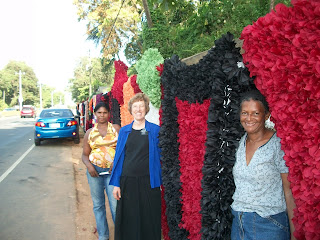It is amazing! There
are some very musical people that live in the DR. Last Monday night we attended
a group Family Home Evening at the “Casa” (Housing for all the Temple
Missionaries). A Dominican Men’s Choir
sang for us and they were outstanding!
Most Chapels we visit do not have a piano and the congregation sings a cappella. The Men’s Choir were amazing achieved unity
in their tone and beautiful harmony.
Our Salt Lake visitors, Kelvyn and Kay Culimore left the DR for
Haiti on Tuesday. They offered much
experience in the major initiatives of Wheelchairs and Food Production. We spent many hours discussing the Food
Initiative which involves growing a garden for now. Most people here do not have land and it is
very difficult for them to a garden, but we gave some ideas for consideration and
will see where the people take it from here.
It is up to individual Ward/Branches to make a proposal before we start
a project.
Wednesday this week, we traveled to Barahona.
After the meeting, as we were driving we
came to an intersection where the traffic signal was not working (a very common
occurance). We came to a near full stop
and then because there was no traffic Wallace drove on through the
intersection. 3 blocks up the road we
were pulled over and given a ticket for driving through the intersection. Wallace argued the light didn’t work, but the
police said to turn and look and sure enough the light was working ! (At least
from his direction). It was a total setup! The process here is you go to a Progressive
Bank (the national bank) with your ticket to pay the fee. We haven’t gone yet, so we don’t know how
much it will be.
From Barahona we traveled to Vicente Noble where we met the local
Branch President who went with us to a little community called Batey 8. This is a Haitian community. Everywhere we have gone to in the Dominican
Republic, every home has a water tank on the roof or a cistern below ground
with a pump and pressure tank. The
reason is that the water can disappear in the public water lines without notice
for hours or days at a time. In the case
of this community, it has a small elevated water tank and one submersible pump
to provide water to the entire community.
The water committee decided to only run water for 3 hours every day beginning
at 5 pm except for the bathing pond shown latter in this report. Everyone has a water spigot in their front
yard, but the keys are removed from all of them. The school in the community is at the very
end of the water system and only receives a trickle of water even when there is
water. They need major repairs to their
water tank, a new pump, drinking fountains, a water filter and to expand the
size of the 1” water line that feeds the school.
We are partnering with World Water Relief on this
project. They will be installing the
pump and a filter. We will be paying for
part of the water system and possibly offering a fence and a couple of
basketball standards to the school. They
need the fence to provide a barrier between the playground and a very large
irrigation ditch.
Notice the “outhouses” in the background of the photo. (One is visible just over Wallace’s right
ear). How would you school kids like to
use those for your bathrooms? (No running water, and the latrines are full).
While at Batey 8 we noticed a couple of families using the
public “bathtub” at the base of the water tank.
It was a hot day and certainly a place to cool off and get a good
shampoo.
Thursday, 28 July, we went to our second closing ceremony for
Innovacion Orthopedia as they fitted 5 patients with new prosthetics.
The above photo features our neighbors, the Hammons, with 4
of the recipients of new prosthetic legs. The girl is 8 years old and was born
with a deformed foot and hand on her right side. The picture below is of
Silvia, a 60 year old that received her first prosthesis. She was referred by a member of the Church
from Canada who met her while in the DR on vacation.


























